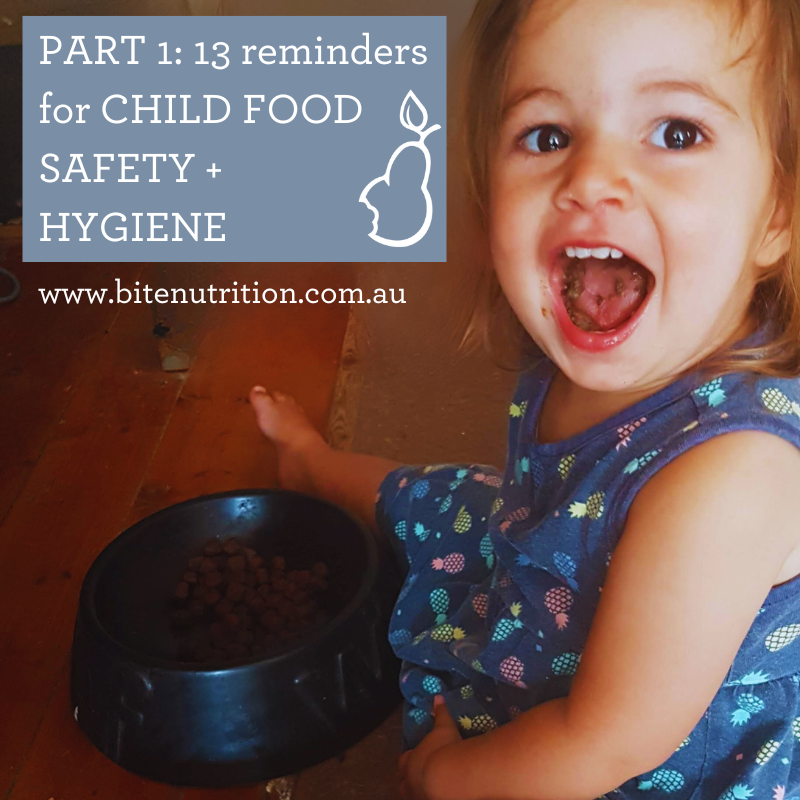13 Reminders for Child Food Safety + Hygiene

Learning about food safety and hygiene is often through our family and peers, or our own independent research. Sometimes our foundational knowledge is spot on, other times it is really off the mark. This article is the first of 3 around food safety and hygiene as it relates to early life food introduction and preparation at home.
Food Safety and Hygiene
Food safety involves all aspects of providing food so that it is safe to eat – managing the risk of choking on food, avoiding allergic reactions, sensitivities and intolerances and ensuring that food is not contaminated in any way.
Food hygiene
Food safety guidelines must always be followed carefully, especially when preparing food for children, whose immune systems are still developing.
Contamination in food can include:
- foreign bodies – hair, pieces of metal or other objects accidentally picked up during the preparation and cooking process
- chemicals from the food production process, or cleaning materials
- natural contaminants, such as toxins present in certain foods
- contamination from pests
What bacteria can be in foods?
There are bacteria present in most foods. Food spoilage is often caused by bacteria, which usually makes food inedible and unpleasant but not necessarily harmful. Certain bacteria, called pathogens, are harmful and can cause food poisoning or gastro-enteritis. Symptoms include nausea, vomiting, diarrhoea and stomach cramps.
Different bacteria cause different illnesses – some can be brief and mild, and others can be very serious, causing dehydration and requiring hospitalisation. Food poisoning is especially serious in children and elderly people because their immune systems are more vulnerable and they become dehydrated more easily.
The most common cause of gastro-enteritis is viral illnesses passed on by contact between people, rather than through food. These symptoms are very common, generally very acute and short-term. Hygiene and hand-washing are very important, to limit the spread of viral gastro-enteritis.
Bacteria grow easily in foods that are moist and have a lot of nutrients. These are called ‘high-risk’ foods. Milk, meat, fish and any dishes containing these foods are considered high-risk. Cooked rice also allows some bacteria to grow. If these foods are left out of the refrigerator for long periods of time, they will spoil and generally not be eaten. However, it is only if they contain harmful pathogenic bacteria that they will cause illness if eaten. Keeping food safe relies on controlling the conditions which allow bacteria to reproduce and grow to large numbers.
What can I do to ensure that food is prepared safely?
- Always wash your hands before handling food – and wash them again if you touch your hair, need to use a tissue to wipe your nose, after sneezing or going to the toilet, or if you touch other items that may carry bacteria.
- Buy food from suppliers you can trust. Buy foods that look fresh, and from places where turnover is high. Make sure that packages are unbroken and products are within their use-by date.
- Always wash your fruit and vegetables before using them, especially if being eaten raw.
- Transport high-risk foods quickly or in cool containers.
- Keep all kitchen areas clean.
- Protect low-risk foods by placing them in sealed containers, once packages are open.
- Use separate cutting boards for raw meat and fish, cooked items (such as meat and vegetables) and fruit. Colour code boards to help you remember to use the right ones.
- Wash knives after use with uncooked meat and fish, and before use with any foods that are ready to be eaten.
- Keep high-risk foods refrigerated before cooking or until they are to be eaten. Place any cooked high-risk foods back in the refrigerator, if not eating them straight away.
- ‘Do not reheat cooked foods more than once. Discard any food that was served and not eaten. Discard any food that was not served, but which has been out of the refrigerator for more than two hours.
- Reheat food until it is steaming hot. Allow it to cool down to serving temperature, then serve immediately.
- Check daily that your refrigerator is working, and that food is cold.
- Wash dishes between use in hot soapy water and leave them to dry, rather than using a tea towel. Alternatively, use a dishwasher.

